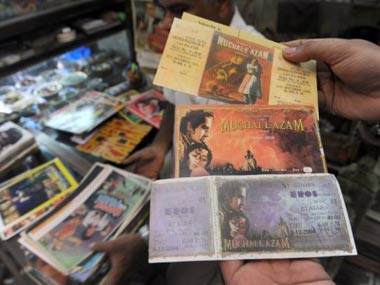It happened in film after film. From Dev Anand and Raj Kapoor to Randhir and Rishi, through two decades of moviemaking, they wooed their heroines with song. They rode bikes, cars, jeeps, and roofs of trains. In An Evening In Paris, Shammi Kapoor even jumped out of a helicopter singing Aasman se Aaya Farishta, a self-appointed angel eager to teach Sharmila Tagore the lesson of love! Wooing with a song that teased, or praised the heroine’s charms to melt her heart was the order of the day back then, a staple part of the boy-meets-girl formula. And even an otherwise soft-spoken, retiring Bharat Bhooshan managed to woo Ameeta with the rather daring Tum ne Kaha Choo, Maine Choo Liya in Saawan (1959). As Dev Anand moved from Nutan to Tanuja, Hema Malini, and Zeenat Aman, his heroines got progressively younger with each passing year, but his modus operandi remained the same: tease them, win them, lose them only to win them again. The formula implied many things. That women dreamed of romance and their ideal man, but were bashful, and needed to be flattered, teased, even annoyed into love. That men were romantics who recognised the woman of their dreams almost at first sight, ready to jump right into song to express this instant, undying love. That serenading a woman as you followed her around was not just romantic, but a potent wooing method guaranteed to melt her heart in the space of three-and-a-half minutes. [caption id=“attachment_68621” align=“alignleft” width=“380” caption=“The song still dominates Hindi films, but heroes no longer sing songs of courtship that seek to woo and teaseAFP Photo”]  [/caption] It was a powerful message. Before long, boys lounging in street corners were singing to girls going home from college, or school; girls in turn were either frightened, irritated, or sometimes flattered. The cult of the Roadside Romeo was born. Such is the power of cinema. An elegant plot device to resolve a narrative problem — the introduction of romance, or the first meeting between the hero and heroine — has become a societal phenomenon. Of course, when translated into life, the results aren’t quite as magical either for the boy or the girl. Serenading romeos may still be a problem on our streets, but they have almost disappeared from the silver screen. In today’s films, be it an Aarakshan or a Delhi Belly, protagonists almost never fall in love at first sight. The “true love will prevail” narrative has been replaced by more complex issues of emotional engagement and commitment, with ‘boys just want to have fun’ being a running motif in films like Ishqiya and Zindagi Na Milegi Dobara. The song still dominates Hindi films, but heroes no longer sing songs of courtship that seek to woo and tease. The lyrics that declare intent are far less romantic and much more overtly suggestive. Where the man once sang about his beloved’s lovable face (Teri Pyaari Pyaari Soorat ko, Kisi ki Nazaar na Lage, from Sasural ), we now have men being sexually direct as in Bhheege Hont Tere in Murder — and women going one step ahead to boldly flaunt their raunchier assets a la Sheila ki jawani. As seduction replaces romance, love may or may not follow. While there is no excusing those roadside romeos, I can’t help but miss those ardent lovers of yore. When I watch a debonair Dev Anand serenade an irate Nutan on his squeaky cycle, singing Mana Janaab ne Pukara Nahin, I know that true love will soon bloom in its full lyrical glory. All the modern-day heroine gets now is some guy asking her to “ undie the condie of the heart”.
Gone are the days when ardent heroes wooed their true love with a song. We may still have serenading romeos on our streets, but they are almost extinct on the silver screen.
Advertisement
End of Article


)
)
)
)
)
)
)
)
)



